New – Lifecycle Management for Amazon EBS Snapshots

|
It is always interesting to zoom in on the history of a single AWS service or feature and watch how it has evolved over time in response to customer feedback. For example, Amazon Elastic Block Store (EBS) launched a decade ago and has been gaining more features and functionality every since. Here are a few of the most significant announcements:
- August 2008 – We launched EBS in production form, with support for volumes of up to 1 TB and snapshots to S3.
- September 2010 – We gave you the ability to Tag EBS Volumes.
- August 2012 – We launched Provisioned IOPS for EBS volumes, allowing you to dial in the level of performance that you need.
- June 2014 – We gave you the ability to create SSD-backed EBS volumes.
- February 2017 – We launched Elastic Volumes, allowing you to adjust the size, performance, and volume type of an active, mounted EBS volume.
- May 2017 – We launched Cost allocation for EBS snapshotsso that you can assign costs to projects, departments, or other entities.
- May 2018 – We announced that encrypted EBS snapshots are now stored incrementally, resulting in a performance improvement and cost savings.
Several of the items that I chose to highlight above make EBS snapshots more useful and more flexible. As you may already know, it is easy to create snapshots. Each snapshot is a point-in-time copy of the blocks that have changed since the previous snapshot, with automatic management to ensure that only the data unique to a snapshot is removed when it is deleted. This incremental model reduces your costs and minimizes the time needed to create a snapshot.
Because snapshots are so easy to create and use, our customers create a lot of them, and make great use of tags to categorize, organize, and manage them. Going back to my list, you can see that we have added multiple tagging features over the years.
Lifecycle Management – The Amazon Data Lifecycle Manager
We want to make it even easier for you to create, use, and benefit from EBS snapshots! Today we are launching Amazon Data Lifecycle Manager to automate the creation, retention, and deletion of Amazon EBS volume snapshots. Instead of creating snapshots manually and deleting them in the same way (or building a tool to do it for you), you simply create a policy, indicating (via tags) which volumes are to be snapshotted, set a retention model, fill in a few other details, and let Data Lifecycle Manager do the rest. Data Lifecycle Manager is powered by tags, so you should start by setting up a clear and comprehensive tagging model for your organization (refer to the links above to learn more).
It turns out that many of our customers have invested in tools to automate the creation of snapshots, but have skimped on the retention and deletion. Sooner or later they receive a surprisingly large AWS bill and find that their scripts are not working as expected. The Data Lifecycle Manager should help them to save money and to be able to rest assured that their snapshots are being managed as expected.
Creating and Using a Lifecycle Policy
Data Lifecycle Manager uses lifecycle policies to figure out when to run, which volumes to snapshot, and how long to keep the snapshots around. You can create the policies in the AWS Management Console, from the AWS Command Line Interface (CLI) or via the Data Lifecycle Manager APIs; I’ll use the Console today. Here are my EBS volumes, all suitably tagged with a department:
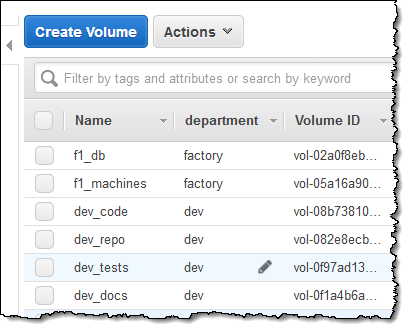
I access the Lifecycle Manager from the Elastic Block Store section of the menu:
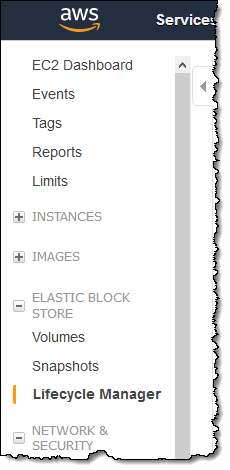
Then I click Create Snapshot Lifecycle Policy to proceed:
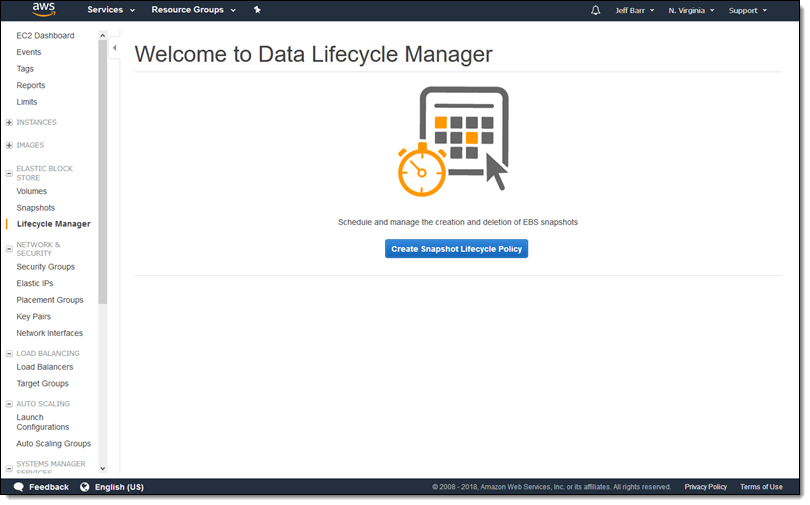
Then I create my first policy:
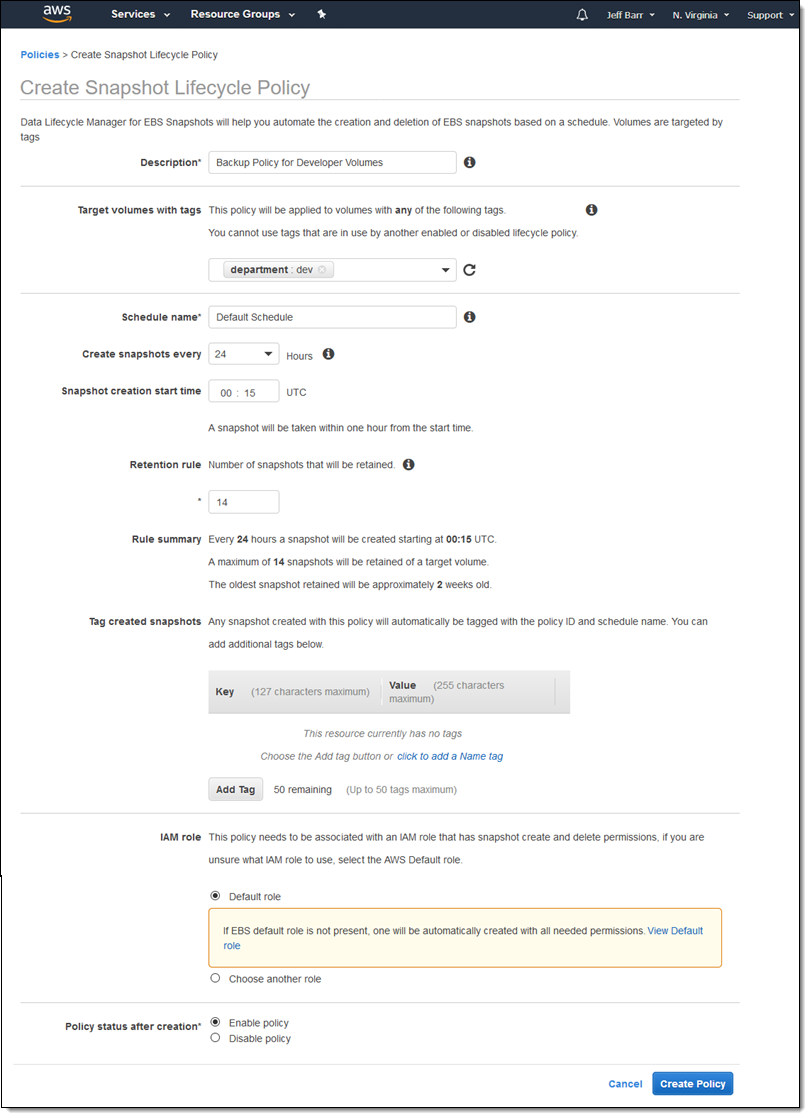
I use tags to specify the volumes that the policy applies to. If I specify multiple tags, then the policy applies to volumes that have any of the tags:
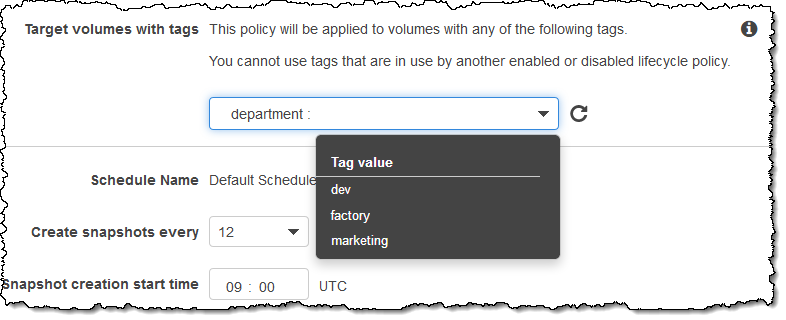
I can create snapshots at 12 or 24 hour intervals, and I can specify the desired snapshot time. Snapshot creation will start no more than an hour after this time, with completion based on the size of the volume and the degree of change since the last snapshot.
I can use the built-in default IAM role or I can create one of my own. If I use my own role, I need to enable the EC2 snapshot operations and all of the DLM (Data Lifecycle Manager) operations; read the docs to learn more.
Newly created snapshots will be tagged with the aws:dlm:lifecycle-policy-id and aws:dlm:lifecycle-schedule-name automatically; I can also specify up to 50 additional key/value pairs for each policy:

I can see all of my policies at a glance:
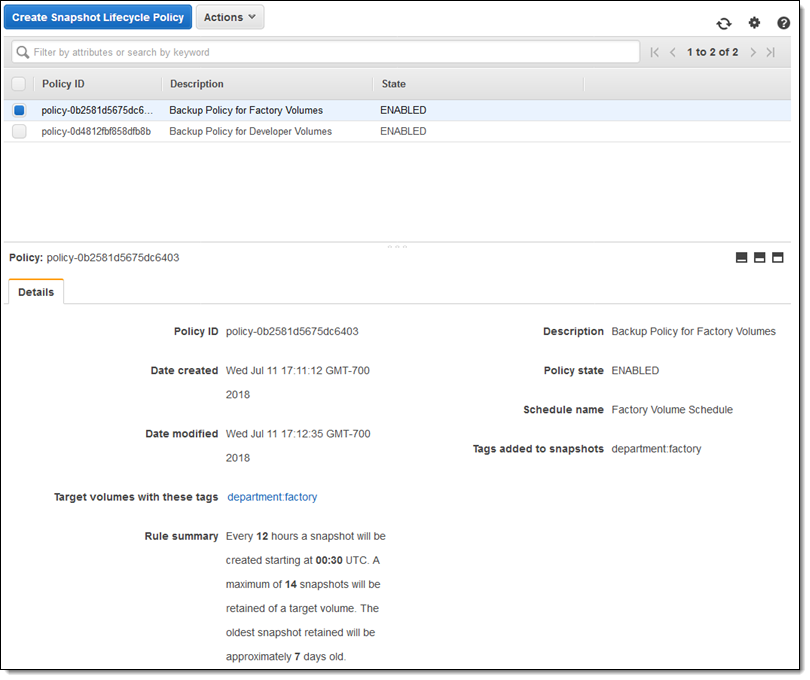
I took a short break and came back to find that the first set of snapshots had been created, as expected (I configured the console to show the two tags created on the snapshots):
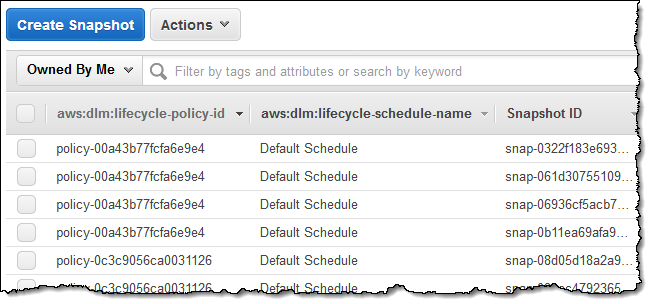
Things to Know
Here are a couple of things to keep in mind when you start to use Data Lifecycle Manager to automate your snapshot management:
Data Consistency – Snapshots will contain the data from all completed I/O operations, also known as crash consistent.
Pricing – You can create and use Data Lifecyle Manager policies at no charge; you pay the usual storage charges for the EBS snapshots that it creates.
Availability – Data Lifecycle Manager is available in the US East (N. Virginia), US West (Oregon), and Europe (Ireland) Regions.
Tags and Policies – If a volume has more than one tag and the tags match multiple policies, each policy will create a separate snapshot and both policies will govern the retention. No two policies can specify the same key/value pair for a tag.
Programmatic Access – You can create and manage policies programmatically! Take a look at the CreateLifecyclePolicy, GetLifecyclePolicies, and UpdateLifeCyclePolicy functions to get started. You can also write an AWS Lambda function in response to the createSnapshot event.
Error Handling – Data Lifecycle Manager generates a “DLM Policy State Change” event if a policy enters the error state.
In the Works – As you might have guessed from the name, we plan to add support for additional AWS data sources over time. We also plan to support policies that will let you do weekly and monthly snapshots, and also expect to give you additional scheduling flexibility.
— Jeff;
相關推薦
New – Custom Metrics for Amazon CloudWatch
You can now store your business and application metrics in Amazon CloudWatch. You can view graphs, set alarms, and initiate automated actions bas
New – VPC Endpoint for Amazon S3
I would like to tell you about a new AWS feature that will allow you to make even better use of Amazon Virtual Private Cloud and Amazon Simple Sto
New – Cost Allocation for EBS Snapshots
Amazon Elastic Block Store (EBS) allows you to create persistent block storage volumes for your Amazon EC2 instances. The volumes offer consistent
New – Encryption of Data in Transit for Amazon EFS
Amazon Elastic File System was designed to be the file system of choice for cloud-native applications that require shared access to file-based sto
New P2 Instance Type for Amazon EC2 – Up to 16 GPUs
I like to watch long-term technology and business trends and watch as they shape the products and services that I get to use and to write about. A
New – Encryption of Data at Rest for Amazon Elastic File System (EFS)
We launched Amazon Elastic File System in production form a little over a year ago (see Amazon Elastic File System – Production Ready in Three Reg
New – Cross-Account Copying of Encrypted EBS Snapshots
AWS already supports the use of encrypted Amazon Elastic Block Store (EBS) volumes and snapshots, with keys stored in and managed by AWS Key Manag
Amazon EBS Update – New Cold Storage and Throughput Options
The AWS team spends a lot of time looking in to ways to deliver innovation based around improvements in price/performance. Quite often, this means
Using Volume Gateway, Clones and EBS Snapshots for Recovery
This AWS Knowledge Center video answers the common question of how to perform recoveries of Volume Gateway volumes. There are multiple options ava
New – GPU-Powered Streaming Instances for Amazon AppStream 2.0
We launched Amazon AppStream 2.0 at re:Invent 2016. This application streaming service allows you to deliver Windows applications to a desktop bro
New – Server-Side Encryption for Amazon Simple Queue Service (SQS)
As one of the most venerable members of the AWS family of services, Amazon Simple Queue Service (SQS) is an essential part of many applications. P
New: Server-Side Encryption for Amazon Kinesis Streams
In this age of smart homes, big data, IoT devices, mobile phones, social networks, chatbots, and game consoles, streaming data scenarios are every
New – Cross-Region Replication for Amazon S3
We launched Amazon S3 nine years ago as of last week! Since that time we have added dozens of features, expanded across the globe, and red
New – Your User Pools for Amazon Cognito
Amazon Cognito makes it easy for mobile and web apps to easily add authentication, user management, and data synchronization without having to wri
預熱Amazon EBS Volumes
預熱Amazon EBS Volumes問題描述及分析處理:最近在做AWS Cloud從CentOS6.9升級到CentOS7.4.1708,系統上跑著oracle數據庫,數據量大概1.5T,準備了一個全新的CentOS7.4.1708 instance,Oracle數據也都rman還原好了,然後對新的ins
Offset Management For Apache Kafka With Apache Spark Streaming
ould cond eth ref properly fine load them sca An ingest pattern that we commonly see being adopted at Cloudera customers is Apache Spark
論文研讀 “Liar, Liar Pants on Fire”:A New Benchmark Dataset for Fake News Detection
給十月畫個句號 最近上的很喜歡的一門課中,老師要求我們研讀一篇頂會論文並進行分享,好久沒能靜靜地坐下來寫一篇部落格了,接下來希望自己能夠多讀論文的同時把論文的思路以部落格的形式輸出~ 論文來源 “Liar, Liar Pants on Fire”:A New Benchmar
